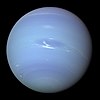
An eclipse is an astronomical event that occurs when an astronomical object or spacecraft is temporarily obscured, by passing into the shadow of another body or by having another body pass between it and the viewer. This alignment of three celestial objects is known as a syzygy. Apart from syzygy, the term eclipse is also used when a spacecraft reaches a position where it can observe two celestial bodies so aligned. An eclipse is the result of either an occultation or a transit.
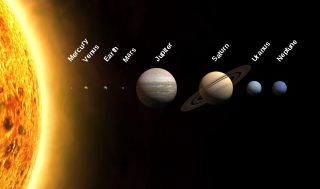
The Solar System is the gravitationally bound system of the Sun and the objects that orbit it. Of the bodies that orbit the Sun directly, the largest are the four gas and ice giants and the four terrestrial planets, followed by an unknown number of dwarf planets and innumerable small Solar System bodies. Of the bodies that orbit the Sun indirectly—the natural satellites—two are larger than Mercury, the smallest terrestrial planet, and one is nearly as large.

Triton is the largest natural satellite of the planet Neptune, and was the first Neptunian moon to be discovered, on October 10, 1846, by English astronomer William Lassell. It is the only large moon in the Solar System with a retrograde orbit, an orbit in the direction opposite to its planet's rotation. Because of its retrograde orbit and composition similar to Pluto, Triton is thought to have been a dwarf planet, captured from the Kuiper belt.
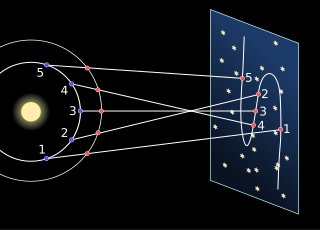
Apparent retrograde motion is the apparent motion of a planet in a direction opposite to that of other bodies within its system, as observed from a particular vantage point. Direct motion or prograde motion is motion in the same direction as other bodies.

A natural satellite is, in the most common usage, an astronomical body that orbits a planet, dwarf planet, or small Solar System body. Natural satellites are often colloquially referred to as moons, a derivation from the Moon of Earth.

An occultation is an event that occurs when one object is hidden by another object that passes between it and the observer. The term is often used in astronomy, but can also refer to any situation in which an object in the foreground blocks from view (occults) an object in the background. In this general sense, occultation applies to the visual scene observed from low-flying aircraft when foreground objects obscure distant objects dynamically, as the scene changes over time.

In astronomy, an extraterrestrial sky is a view of outer space from the surface of an astronomical body other than Earth.
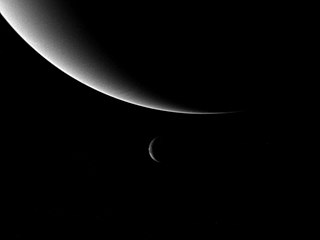
The planet Neptune has 14 known moons, which are named for minor water deities in Greek mythology. By far the largest of them is Triton, discovered by William Lassell on October 10, 1846, 17 days after the discovery of Neptune itself; over a century passed before the discovery of the second natural satellite, Nereid. Neptune's outermost moon Neso, which has an orbital period of about 26 Julian years, orbits farther from its planet than any other moon in the Solar System.

In many cases astronomical phenomena viewed from the planet Mars are the same or similar to those seen from Earth but sometimes they can be quite different. For example, because the atmosphere of Mars does not contain an ozone layer, it is also possible to make UV observations from the surface of Mars.
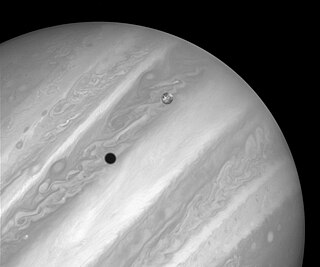
Solar eclipses on Jupiter occur when any of the natural satellites of Jupiter pass in front of the Sun as seen from the planet Jupiter.
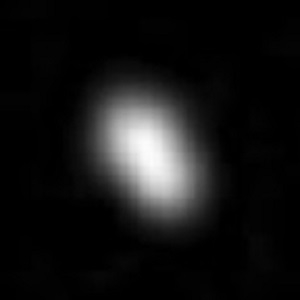
The dwarf planet Pluto has five natural satellites. In order of distance from Pluto, they are Charon, Styx, Nix, Kerberos, and Hydra. Charon, the largest, is mutually tidally locked with Pluto, and is massive enough that Pluto–Charon is sometimes considered a double dwarf planet.

A solar eclipse occurs when a portion of the Earth is engulfed in a shadow cast by the Moon which fully or partially blocks sunlight. This occurs when the Sun, Moon and Earth are aligned. Such alignment coincides with a new moon (syzygy) indicating the Moon is closest to the ecliptic plane. In a total eclipse, the disk of the Sun is fully obscured by the Moon. In partial and annular eclipses, only part of the Sun is obscured.

In astronomy, an irregular moon, irregular satellite or irregular natural satellite is a natural satellite following a distant, inclined, and often eccentric and retrograde orbit. They have been captured by their parent planet, unlike regular satellites, which formed in orbit around them. Irregular moons have a stable orbit, unlike temporary satellites which often have similarly irregular orbits but will eventually depart. The term does not refer to shape as Triton is a round moon, but is considered irregular due to its orbit.
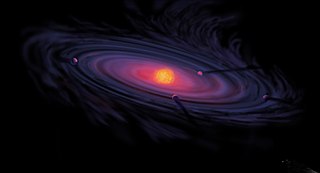
The formation of the Solar System began about 4.6 billion years ago with the gravitational collapse of a small part of a giant molecular cloud. Most of the collapsing mass collected in the center, forming the Sun, while the rest flattened into a protoplanetary disk out of which the planets, moons, asteroids, and other small Solar System bodies formed.

The two moons of Mars, Phobos and Deimos, are much smaller than Earth's Moon, greatly reducing the frequency of solar eclipses on that planet. Neither moon's apparent diameter is large enough to cover the disk of the Sun, and therefore they are annular solar eclipses and can also be considered transits.

Retrograde motion in astronomy is, in general, orbital or rotational motion of an object in the direction opposite the rotation of its primary, that is, the central object. It may also describe other motions such as precession or nutation of an object's rotational axis. Prograde or direct motion is more normal motion in the same direction as the primary rotates. However, "retrograde" and "prograde" can also refer to an object other than the primary if so described. The direction of rotation is determined by an inertial frame of reference, such as distant fixed stars.

Solar eclipses on Uranus occur when any of the natural satellites of Uranus passes in front of the Sun as seen from Uranus. Eclipses can occur only near a solar ring plane-crossing of Uranus (equinox), occurring approximately every 42 years, with the last crossing being in 2007/2008.

Solar eclipses on Saturn occur when the natural satellites of Saturn pass in front of the Sun as seen from Saturn. These eclipses happen fairly often. For example, some of Saturn's moons can have a solar eclipse every day depending on the saturnian season.
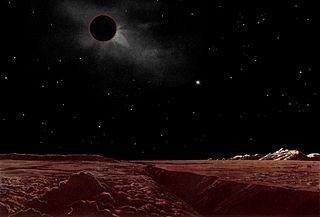
Solar eclipses on the Moon are caused when the planet Earth passes in front of the Sun and blocks its light. Viewers on Earth experience a lunar eclipse during a solar eclipse on the Moon.
The word "transit" refers to cases where the nearer object appears smaller than the more distant object. Cases where the nearer object appears larger and completely hides the more distant object are known as occultations.





















